Case Study Analysis: Patient with Type 1 Diabetes and Complications
VerifiedAdded on 2022/10/19
|5
|1127
|393
Case Study
AI Summary
This case study analyzes the case of a 33-year-old patient, Mr. Brett Howard, diagnosed with Type 1 diabetes, who exhibits poor adherence to insulin therapy and suffers from complications including peripheral neuropathy and a foot infection. The assignment details the patient's medical history, including previous hospitalizations and co-existing conditions like anxiety, depression, and substance use. The student outlines the responsibilities of patient care, including monitoring vital signs, administering medications, and conducting assessments. The analysis highlights the patient's physical and mental state, the need for nurse-patient communication, and the importance of addressing complications like increased blood pressure and potential infection spread. The case study emphasizes the impact of lifestyle factors such as alcohol consumption and proposes an action plan to improve nursing relationships and patient care, including the use of insulin pumps for better diabetes management. References to relevant medical literature are also provided.
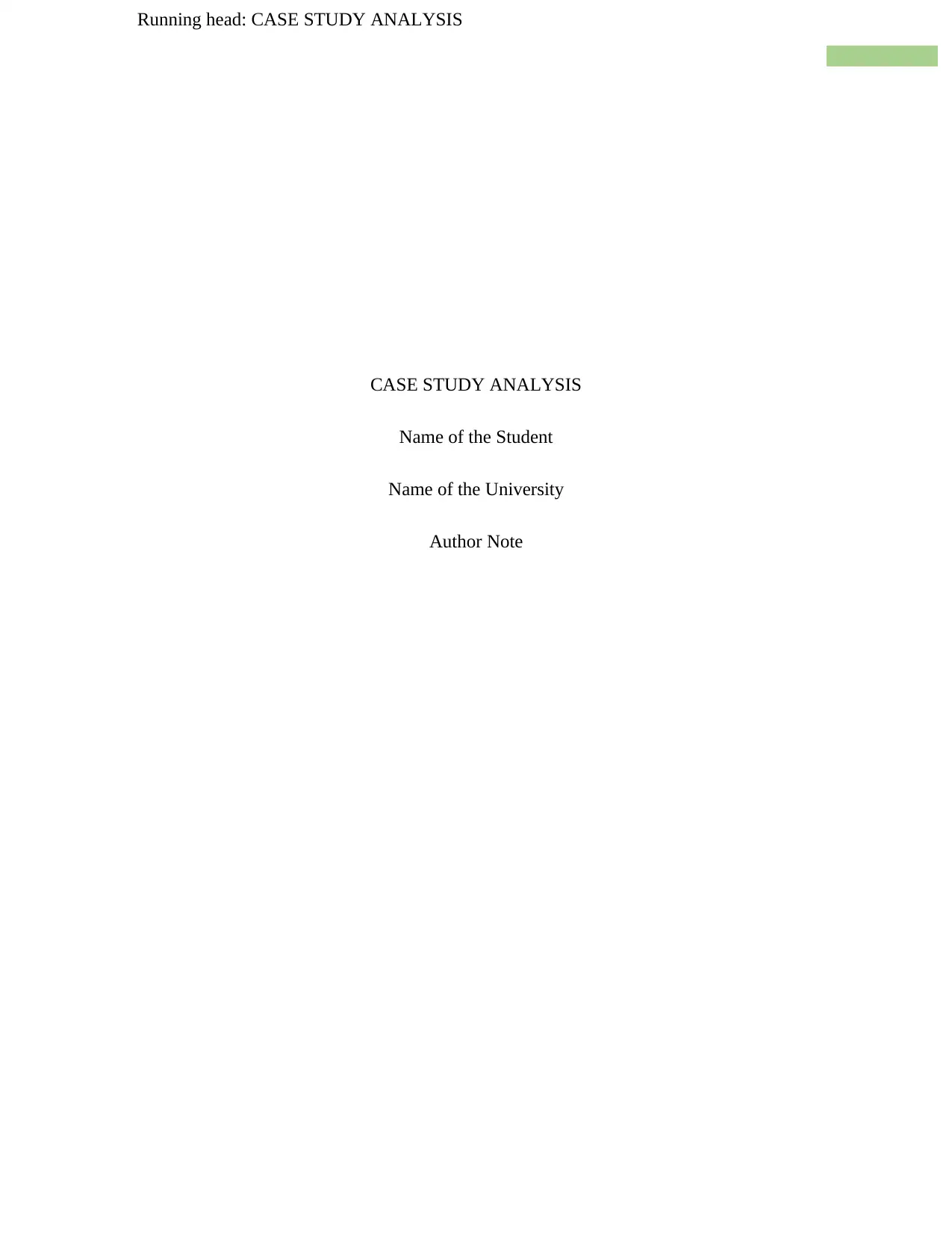
Running head: CASE STUDY ANALYSIS
CASE STUDY ANALYSIS
Name of the Student
Name of the University
Author Note
CASE STUDY ANALYSIS
Name of the Student
Name of the University
Author Note
Paraphrase This Document
Need a fresh take? Get an instant paraphrase of this document with our AI Paraphraser
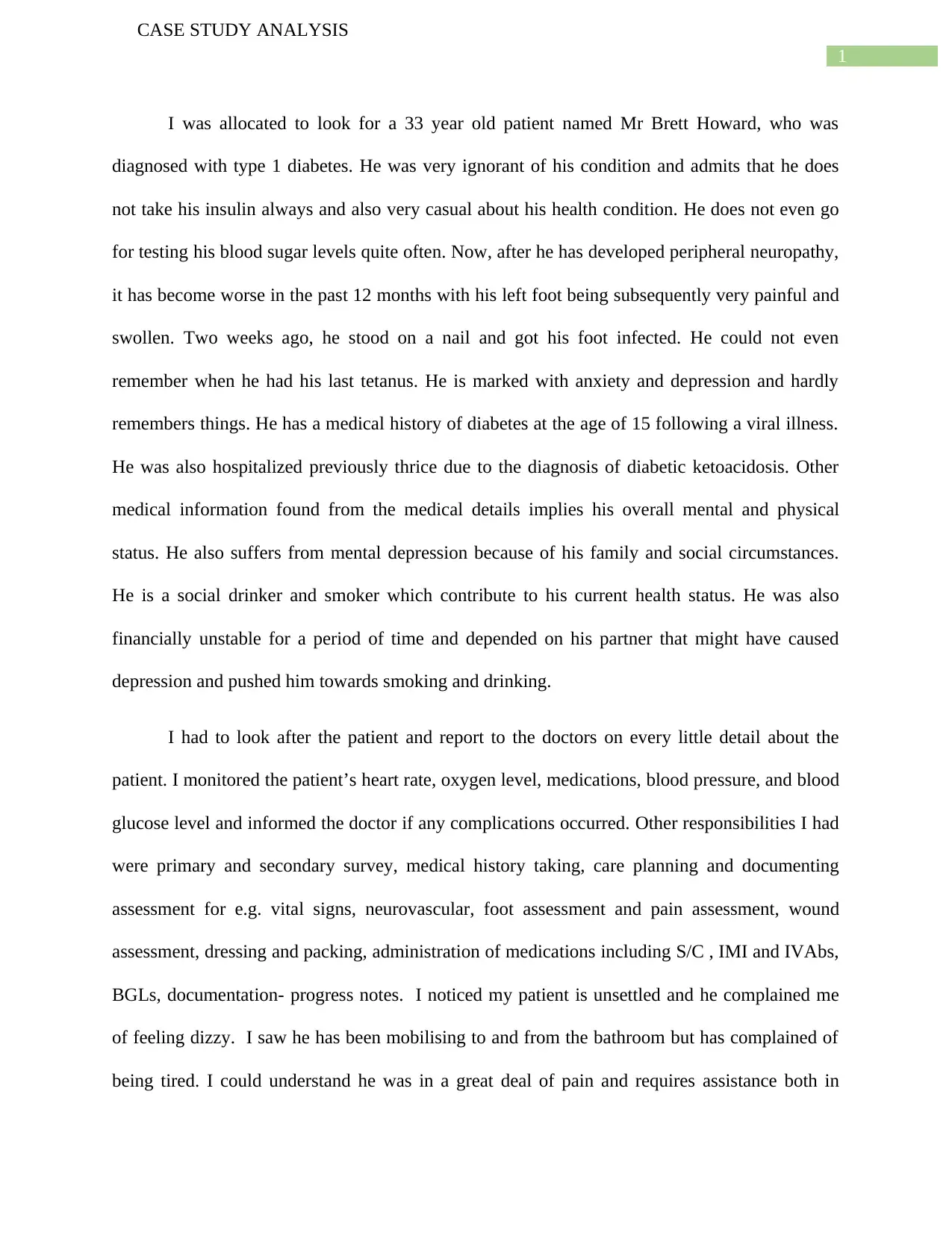
1
CASE STUDY ANALYSIS
I was allocated to look for a 33 year old patient named Mr Brett Howard, who was
diagnosed with type 1 diabetes. He was very ignorant of his condition and admits that he does
not take his insulin always and also very casual about his health condition. He does not even go
for testing his blood sugar levels quite often. Now, after he has developed peripheral neuropathy,
it has become worse in the past 12 months with his left foot being subsequently very painful and
swollen. Two weeks ago, he stood on a nail and got his foot infected. He could not even
remember when he had his last tetanus. He is marked with anxiety and depression and hardly
remembers things. He has a medical history of diabetes at the age of 15 following a viral illness.
He was also hospitalized previously thrice due to the diagnosis of diabetic ketoacidosis. Other
medical information found from the medical details implies his overall mental and physical
status. He also suffers from mental depression because of his family and social circumstances.
He is a social drinker and smoker which contribute to his current health status. He was also
financially unstable for a period of time and depended on his partner that might have caused
depression and pushed him towards smoking and drinking.
I had to look after the patient and report to the doctors on every little detail about the
patient. I monitored the patient’s heart rate, oxygen level, medications, blood pressure, and blood
glucose level and informed the doctor if any complications occurred. Other responsibilities I had
were primary and secondary survey, medical history taking, care planning and documenting
assessment for e.g. vital signs, neurovascular, foot assessment and pain assessment, wound
assessment, dressing and packing, administration of medications including S/C , IMI and IVAbs,
BGLs, documentation- progress notes. I noticed my patient is unsettled and he complained me
of feeling dizzy. I saw he has been mobilising to and from the bathroom but has complained of
being tired. I could understand he was in a great deal of pain and requires assistance both in
CASE STUDY ANALYSIS
I was allocated to look for a 33 year old patient named Mr Brett Howard, who was
diagnosed with type 1 diabetes. He was very ignorant of his condition and admits that he does
not take his insulin always and also very casual about his health condition. He does not even go
for testing his blood sugar levels quite often. Now, after he has developed peripheral neuropathy,
it has become worse in the past 12 months with his left foot being subsequently very painful and
swollen. Two weeks ago, he stood on a nail and got his foot infected. He could not even
remember when he had his last tetanus. He is marked with anxiety and depression and hardly
remembers things. He has a medical history of diabetes at the age of 15 following a viral illness.
He was also hospitalized previously thrice due to the diagnosis of diabetic ketoacidosis. Other
medical information found from the medical details implies his overall mental and physical
status. He also suffers from mental depression because of his family and social circumstances.
He is a social drinker and smoker which contribute to his current health status. He was also
financially unstable for a period of time and depended on his partner that might have caused
depression and pushed him towards smoking and drinking.
I had to look after the patient and report to the doctors on every little detail about the
patient. I monitored the patient’s heart rate, oxygen level, medications, blood pressure, and blood
glucose level and informed the doctor if any complications occurred. Other responsibilities I had
were primary and secondary survey, medical history taking, care planning and documenting
assessment for e.g. vital signs, neurovascular, foot assessment and pain assessment, wound
assessment, dressing and packing, administration of medications including S/C , IMI and IVAbs,
BGLs, documentation- progress notes. I noticed my patient is unsettled and he complained me
of feeling dizzy. I saw he has been mobilising to and from the bathroom but has complained of
being tired. I could understand he was in a great deal of pain and requires assistance both in
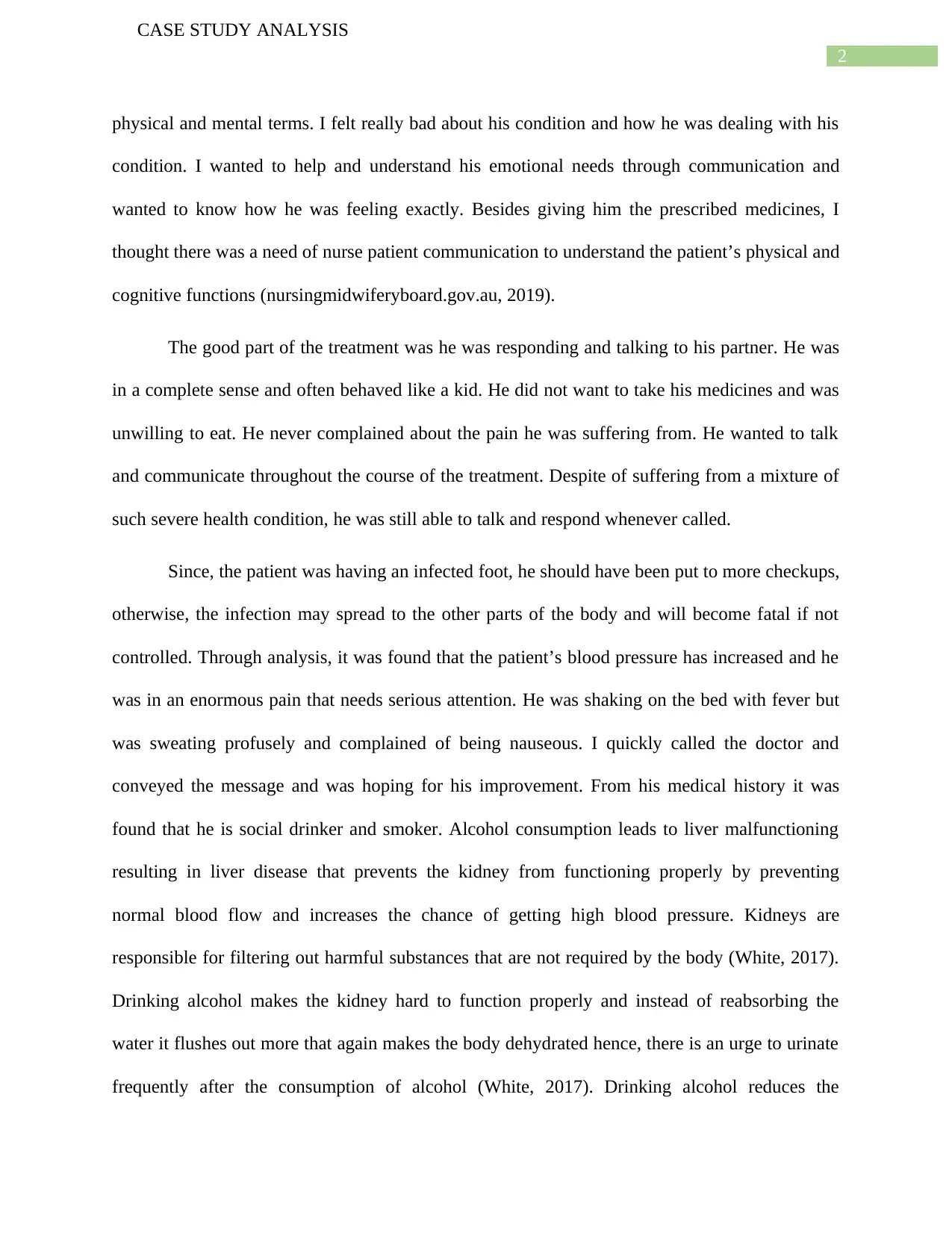
2
CASE STUDY ANALYSIS
physical and mental terms. I felt really bad about his condition and how he was dealing with his
condition. I wanted to help and understand his emotional needs through communication and
wanted to know how he was feeling exactly. Besides giving him the prescribed medicines, I
thought there was a need of nurse patient communication to understand the patient’s physical and
cognitive functions (nursingmidwiferyboard.gov.au, 2019).
The good part of the treatment was he was responding and talking to his partner. He was
in a complete sense and often behaved like a kid. He did not want to take his medicines and was
unwilling to eat. He never complained about the pain he was suffering from. He wanted to talk
and communicate throughout the course of the treatment. Despite of suffering from a mixture of
such severe health condition, he was still able to talk and respond whenever called.
Since, the patient was having an infected foot, he should have been put to more checkups,
otherwise, the infection may spread to the other parts of the body and will become fatal if not
controlled. Through analysis, it was found that the patient’s blood pressure has increased and he
was in an enormous pain that needs serious attention. He was shaking on the bed with fever but
was sweating profusely and complained of being nauseous. I quickly called the doctor and
conveyed the message and was hoping for his improvement. From his medical history it was
found that he is social drinker and smoker. Alcohol consumption leads to liver malfunctioning
resulting in liver disease that prevents the kidney from functioning properly by preventing
normal blood flow and increases the chance of getting high blood pressure. Kidneys are
responsible for filtering out harmful substances that are not required by the body (White, 2017).
Drinking alcohol makes the kidney hard to function properly and instead of reabsorbing the
water it flushes out more that again makes the body dehydrated hence, there is an urge to urinate
frequently after the consumption of alcohol (White, 2017). Drinking alcohol reduces the
CASE STUDY ANALYSIS
physical and mental terms. I felt really bad about his condition and how he was dealing with his
condition. I wanted to help and understand his emotional needs through communication and
wanted to know how he was feeling exactly. Besides giving him the prescribed medicines, I
thought there was a need of nurse patient communication to understand the patient’s physical and
cognitive functions (nursingmidwiferyboard.gov.au, 2019).
The good part of the treatment was he was responding and talking to his partner. He was
in a complete sense and often behaved like a kid. He did not want to take his medicines and was
unwilling to eat. He never complained about the pain he was suffering from. He wanted to talk
and communicate throughout the course of the treatment. Despite of suffering from a mixture of
such severe health condition, he was still able to talk and respond whenever called.
Since, the patient was having an infected foot, he should have been put to more checkups,
otherwise, the infection may spread to the other parts of the body and will become fatal if not
controlled. Through analysis, it was found that the patient’s blood pressure has increased and he
was in an enormous pain that needs serious attention. He was shaking on the bed with fever but
was sweating profusely and complained of being nauseous. I quickly called the doctor and
conveyed the message and was hoping for his improvement. From his medical history it was
found that he is social drinker and smoker. Alcohol consumption leads to liver malfunctioning
resulting in liver disease that prevents the kidney from functioning properly by preventing
normal blood flow and increases the chance of getting high blood pressure. Kidneys are
responsible for filtering out harmful substances that are not required by the body (White, 2017).
Drinking alcohol makes the kidney hard to function properly and instead of reabsorbing the
water it flushes out more that again makes the body dehydrated hence, there is an urge to urinate
frequently after the consumption of alcohol (White, 2017). Drinking alcohol reduces the
⊘ This is a preview!⊘
Do you want full access?
Subscribe today to unlock all pages.

Trusted by 1+ million students worldwide
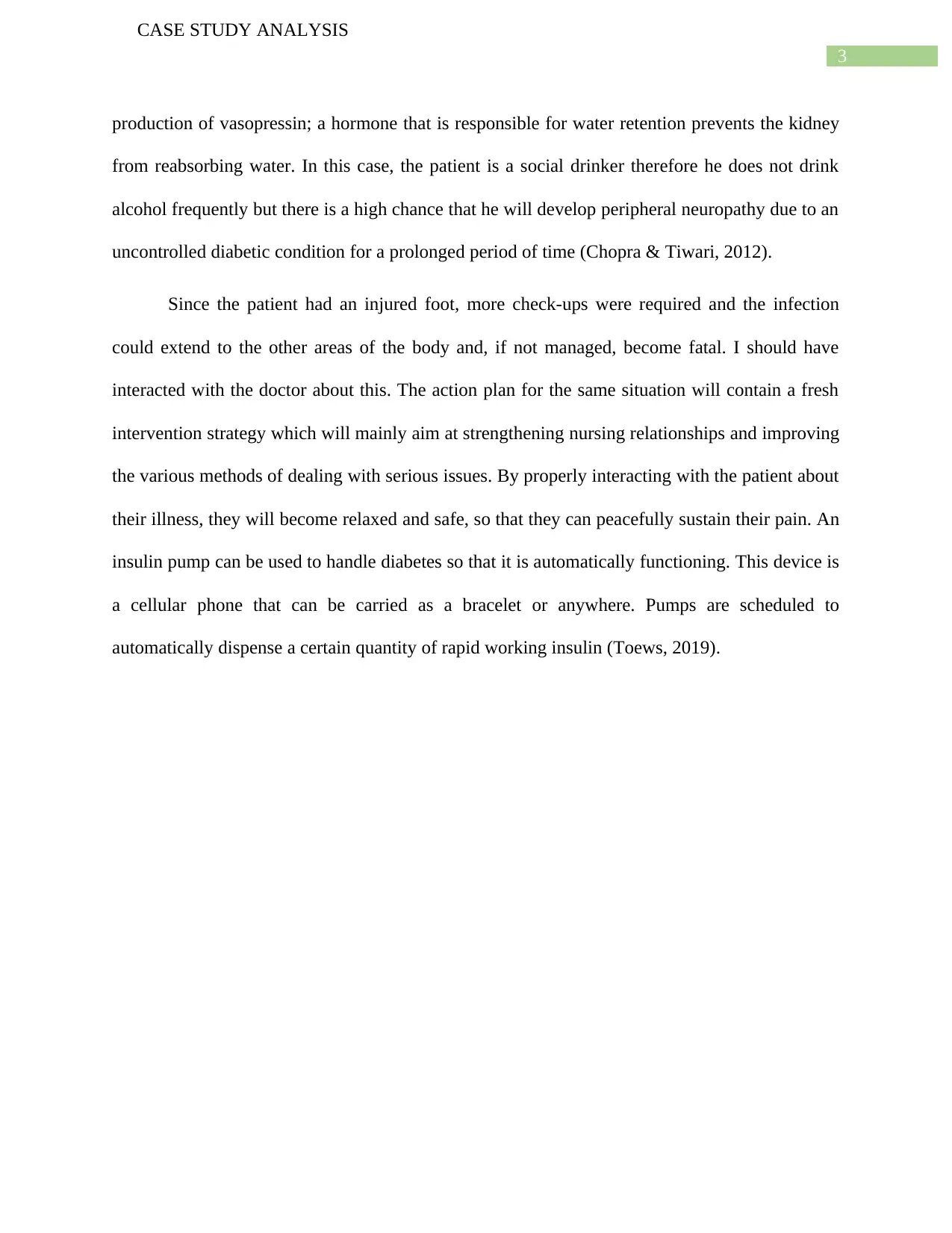
3
CASE STUDY ANALYSIS
production of vasopressin; a hormone that is responsible for water retention prevents the kidney
from reabsorbing water. In this case, the patient is a social drinker therefore he does not drink
alcohol frequently but there is a high chance that he will develop peripheral neuropathy due to an
uncontrolled diabetic condition for a prolonged period of time (Chopra & Tiwari, 2012).
Since the patient had an injured foot, more check-ups were required and the infection
could extend to the other areas of the body and, if not managed, become fatal. I should have
interacted with the doctor about this. The action plan for the same situation will contain a fresh
intervention strategy which will mainly aim at strengthening nursing relationships and improving
the various methods of dealing with serious issues. By properly interacting with the patient about
their illness, they will become relaxed and safe, so that they can peacefully sustain their pain. An
insulin pump can be used to handle diabetes so that it is automatically functioning. This device is
a cellular phone that can be carried as a bracelet or anywhere. Pumps are scheduled to
automatically dispense a certain quantity of rapid working insulin (Toews, 2019).
CASE STUDY ANALYSIS
production of vasopressin; a hormone that is responsible for water retention prevents the kidney
from reabsorbing water. In this case, the patient is a social drinker therefore he does not drink
alcohol frequently but there is a high chance that he will develop peripheral neuropathy due to an
uncontrolled diabetic condition for a prolonged period of time (Chopra & Tiwari, 2012).
Since the patient had an injured foot, more check-ups were required and the infection
could extend to the other areas of the body and, if not managed, become fatal. I should have
interacted with the doctor about this. The action plan for the same situation will contain a fresh
intervention strategy which will mainly aim at strengthening nursing relationships and improving
the various methods of dealing with serious issues. By properly interacting with the patient about
their illness, they will become relaxed and safe, so that they can peacefully sustain their pain. An
insulin pump can be used to handle diabetes so that it is automatically functioning. This device is
a cellular phone that can be carried as a bracelet or anywhere. Pumps are scheduled to
automatically dispense a certain quantity of rapid working insulin (Toews, 2019).
Paraphrase This Document
Need a fresh take? Get an instant paraphrase of this document with our AI Paraphraser
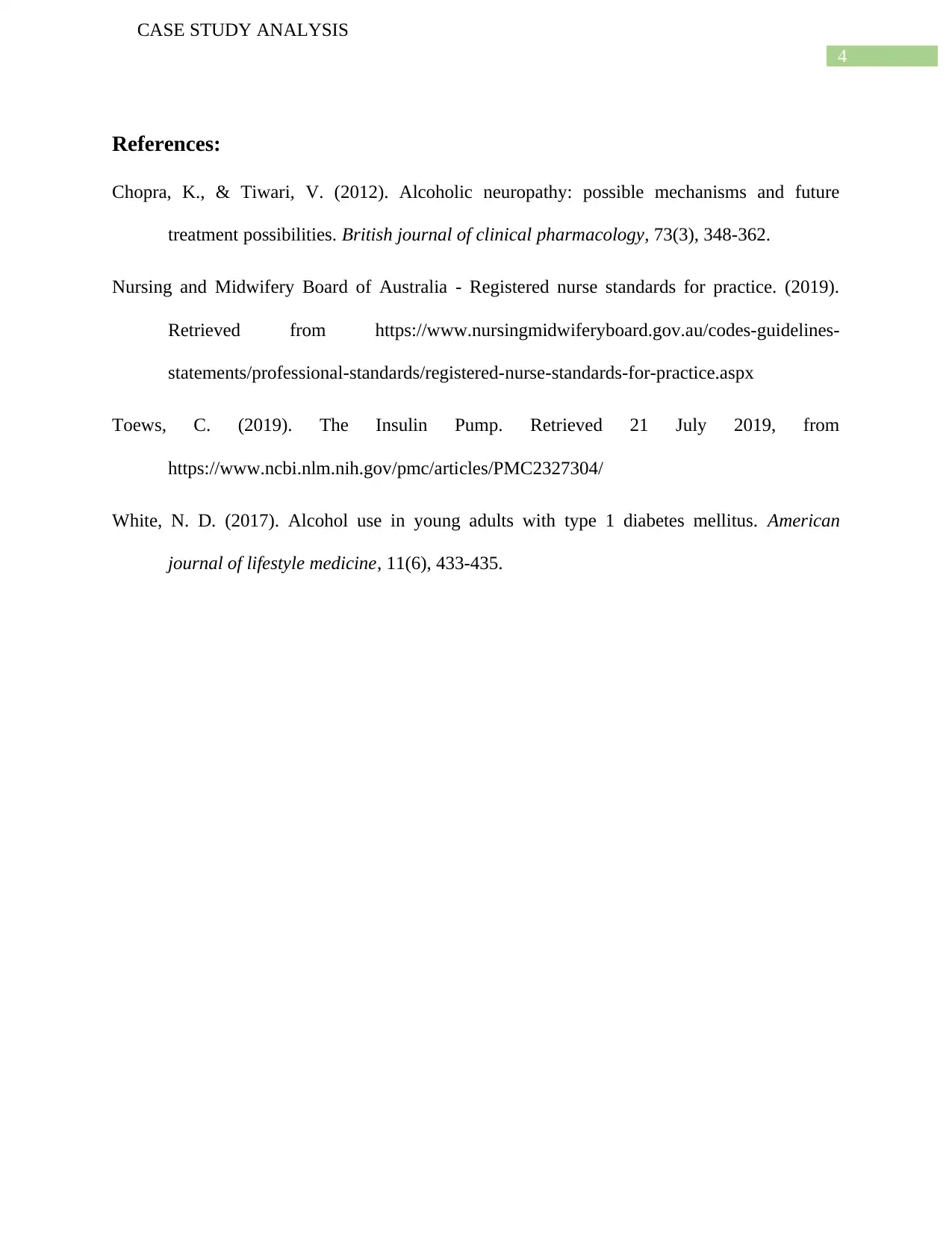
4
CASE STUDY ANALYSIS
References:
Chopra, K., & Tiwari, V. (2012). Alcoholic neuropathy: possible mechanisms and future
treatment possibilities. British journal of clinical pharmacology, 73(3), 348-362.
Nursing and Midwifery Board of Australia - Registered nurse standards for practice. (2019).
Retrieved from https://www.nursingmidwiferyboard.gov.au/codes-guidelines-
statements/professional-standards/registered-nurse-standards-for-practice.aspx
Toews, C. (2019). The Insulin Pump. Retrieved 21 July 2019, from
https://www.ncbi.nlm.nih.gov/pmc/articles/PMC2327304/
White, N. D. (2017). Alcohol use in young adults with type 1 diabetes mellitus. American
journal of lifestyle medicine, 11(6), 433-435.
CASE STUDY ANALYSIS
References:
Chopra, K., & Tiwari, V. (2012). Alcoholic neuropathy: possible mechanisms and future
treatment possibilities. British journal of clinical pharmacology, 73(3), 348-362.
Nursing and Midwifery Board of Australia - Registered nurse standards for practice. (2019).
Retrieved from https://www.nursingmidwiferyboard.gov.au/codes-guidelines-
statements/professional-standards/registered-nurse-standards-for-practice.aspx
Toews, C. (2019). The Insulin Pump. Retrieved 21 July 2019, from
https://www.ncbi.nlm.nih.gov/pmc/articles/PMC2327304/
White, N. D. (2017). Alcohol use in young adults with type 1 diabetes mellitus. American
journal of lifestyle medicine, 11(6), 433-435.
1 out of 5
Related Documents
Your All-in-One AI-Powered Toolkit for Academic Success.
+13062052269
info@desklib.com
Available 24*7 on WhatsApp / Email
![[object Object]](/_next/static/media/star-bottom.7253800d.svg)
Unlock your academic potential
Copyright © 2020–2025 A2Z Services. All Rights Reserved. Developed and managed by ZUCOL.




